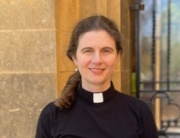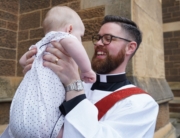Trinity: Mystery and Wonder
Preacher: The Very Rev’d Frank Nelson
Readings: Proverbs 8: 1 – 4, 22 – 31, Psalm 8, Romans 5: 1 – 5, John 16: 12 – 15
On my 10th birthday my parents gave me a prayer book, this one. It is a beautiful book, leather-bound with very fine paper. First published in 1954, it is entitled “A Book of Common Prayer” and was authorised by the General Synod of the Church of the Province of South Africa. Already aware of God’s call to the priesthood, I carried it proudly into church each week. There we used it for the service of Holy Communion, complete with prayers for Elizabeth our Queen. I mention that for two reasons – one, that the date of publishing is significant (Elizabeth was crowned in 1953 so this was clearly a new edition reflecting the new monarch); the other, that one of my early memories, as a six year old, was waving the flag of the new Republic of South Africa on 31st May 1961, along with all my other class mates in our first year of school, on the day South Africa left the Commonwealth to become a republic. Years later, in 1994, I made a declaration of allegiance to her majesty, Queen, among other places, of New Zealand. At much the same time of course, South Africa returned to the Commonwealth after the exile of the Apartheid years.
Services and sermons were very long for a boy of ten and something needed to be done to keep a young treble and then server awake during what seemed the interminable sermons and intercessions. I discovered page 21 in my prayer book with the exotic, and totally inexplicable, Latin title “Quicunque Vult”. Without a clue what it meant, and the English translation did not seem to help much either, I loved the sound of that phrase, “Quicunque vult.” It is of course, the original title of a statement of faith, written in Latin (which says something about its origin and dating) concerning the Holy Trinity. Particularly in the Middle Ages the recitation, in Latin, of the “Quicunque vult”, or, to give it its English title, the Athanasian Creed, became extremely popular. The rubrics in my leather-bound prayer book state that ‘the following canticle shall be said, either in place of the Apostles’ Creed, or as an anthem at Morning and Evening Prayer on Trinity Sunday. It shall also be said on the following Feasts – St Andrew, St Thomas, the Conversion of St Paul, St Matthias, the Annunciation, St Mark, St John the Baptist, St James, St Bartholomew, St Matthew, St Simon and St Jude.” In other words, the major festivals of the church, outside of Christmas, Easter and Pentecost. I have to confess that I can’t recall ever saying, in full, the “Quicunque vult”! (By the way, it is tucked away at the very back of A Prayer Book for Australia.)
It was always the Latin title, “Quicunque vult,” that fascinated me, that drew me into mystery and wonder. And it is those two words, mystery and wonder, that I believe is at the heart of the Trinity. Athanasius, who wrote exclusively in Greek (hence the doubt that he was the author of the Creed that bears his name), was one of the great teachers and thinkers of the 4th century church; a time when debates around the nature of Christ – human or divine – and of God swirled around. From that period we get the Nicene Creed, properly called the Niceno-Constantinopolitan Creed, for it took some fifty years and a number of ecumenical councils to reach agreement. And even then there were plenty of church people who could not accept it in full. The opening words in Greek signal clearly that this is a statement of belief to be said by everyone. Πιστεύομεν εἰς ἕνα θεὸν – We believe in One God. This plural form of beginning has always been used in the Orthodox Church. In the Latin-speaking West it became singular, “I believe”, perhaps influenced by the older Apostles’ Creed, which is a baptismal creed, and was only restored to its plural form in the liturgical movement and new prayer books of the late 20th century.
But what about the mystery of the Trinity – for it is a mystery? The great Ecumenical Councils of the 4th and 5th centuries thought they had got it right, but theologians and philosophers are still writing books and learned treatises trying to explain the Trinity – this concept of unity in trinity and trinity in unity. Would that Jesus had given some clear teaching – but he didn’t! Rather, there are hints and suggestions that God can be known as Father, as Son and as Holy Spirit. And there lies the problem. Are we talking about one god or three? And what to make of the conversations, apparently at times extremely heated in the equivalent of the ancient coffee shops and pubs, swirling around words like ‘homoousias’, ‘statis’, nature and substance?
Examples were thought of, along with diagrams, to explain what was meant. Among them is the famous “Shield of the Trinity” – God in the centre, Father, Son and Holy Spirit at each point of the triangle. The flowing movement of the beautiful and intriguing triquetra of the Celtic knot, with its three corners and circle of life is another common and popular symbol. I have often used the idea of the chemical equation H2O as an example – where it can be found as liquid, steam or ice; or myself, Frank Nelson, being a son, a husband and a father – three quite different relationships, but the same person. Of course, no sooner do we use such an illustration than we need to acknowledge that it does not say enough, is not quite right, and probably should not be used at all!
So what can we say about the Trinity? As I have said, I think there are two words to use in association with Trinity – mystery and wonder. There are enough biblical references to invite us into the mystery of God. Jesus, whom St John described as the Word, the Life, the Light (and a host of other things), himself used the word “Father” when he spoke of God and, remembering the great Feast of Pentecost last week, spoke many times of the coming of the Holy Spirit. The last few verse of Mathew’s Gospel, often called the Great Commission, talk of the Apostles being sent out into the world to baptise people in the name of the Father, and the Son and the Holy Spirit, which is exactly what we will do next Sunday morning when a number of people are baptised. The name of God, given to Moses at the burning bush, invites us to live with the mystery of God – the one whose name is simply “I Am”. (Exodus 3) I am who I am; I will be who I will be – there is no one who can control God for God, in the words of the Creed is the maker, the creator, of all that is, seen and unseen.
But it is the second word, wonder, that really excites me. It is the word which captures the sentiment of Psalm 8; “O Lord our governor how glorious is your name in all the earth! … When I consider your heavens, the work of your fingers, the moon and the stars … what are we, that you should be mindful of us.” Who am I? What am I that God should care? In one of the alternate readings for Trinity Sunday Isaiah finds himself caught up in wonder as he gazes at the Lord, seated high and lifted up, his train filling the temple while the angels cry “Holy, holy, holy is the Lord.” (Isaiah 6). The writer of Proverbs mused on the nature of Wisdom; St John wrote about the Logos; Ezekiel talked of the mystery of God in terms of wheels and strange creatures with eyes and wings; the final book in the Bible, Revelation, frequently invites us to gaze on heaven and sing the praises of God.
Great as the mystery of God the Creator is, even so is the mystery of God the Son, the Saviour, by whose grace, according to St Paul, we are saved. That is a thing of wonder. “Amazing Grace, how sweet the sound that saved a wretch like me” sang John Newton, slave trader turned preacher. And, adds St Paul in today’s reading from Romans, our sufferings result in endurance, character and hope because “God’s love has been poured into our hearts through the Holy Spirit that has been given to us.” (Romans 5: 5) How do we make sense of the grace of God, the gift and gifts of the Holy Spirit, other than through cultivating a sense of wonder? Both scary and wonderful.
The Celtic Christians of ancient days were not afraid to acknowledge the Trinity, and make it part of their daily lives. The well-known St Patrick’s Breastplate begins “I bind unto myself today the strong name of the Trinity, by invocation of the same, the Three in One, and One in Three.” They lived with the mystery and the wonder of the Trinity – making it a very normal part of their lives.
On the front page of today’s service booklet is a poem and a sketch. It was written by Christine at a particularly dark time in her life, when, as the MS seemed to be progressing, faith and the mystery and wonder that faith in God brings, were hard to come by. It may be that it resonates with others today.
O Trinity, O Unity, be present as we worship thee; and with the songs that angels sing untie the hymns of praise we bring.
Words: Latin c 10th century





